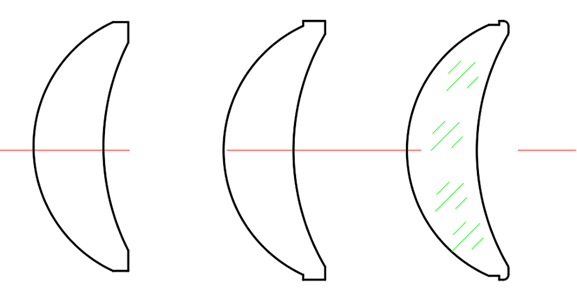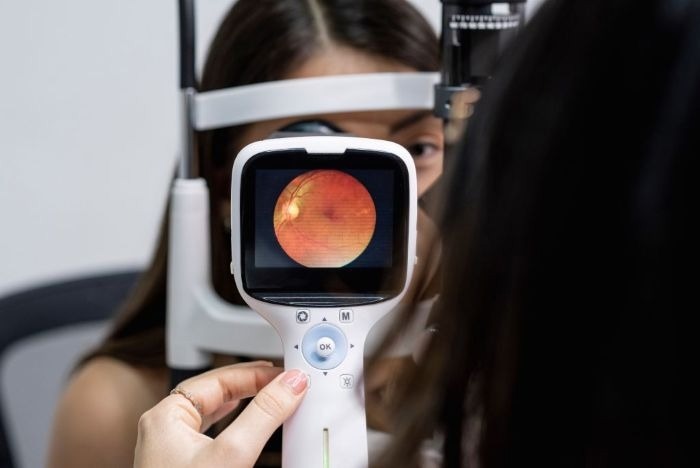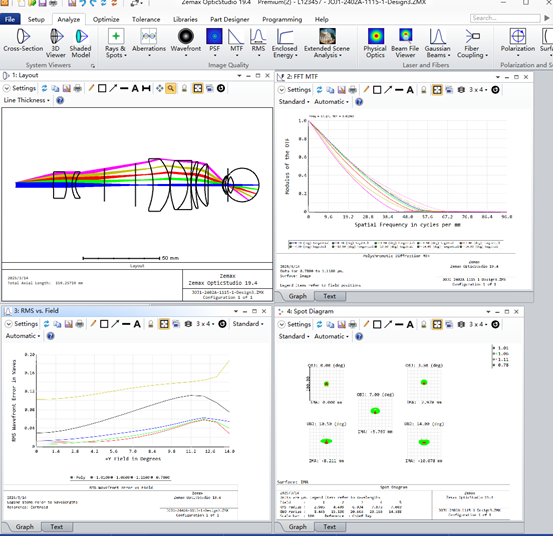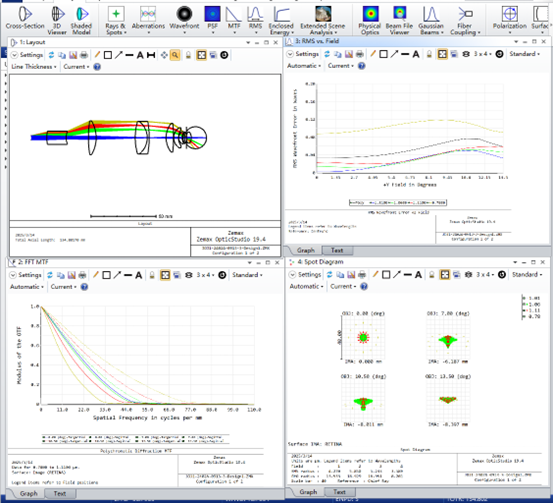Medical detection lenses developed for identifying eye diseases are classified into two categories based on optical working distance: long-distance detection lenses and zero-distance detection lenses.
Long-distance detection lens (Approximately 15 MM from the eye)
- Advantages: The non-contact design ensures safety, allowing for painless lesion detection that minimizes discomfort and enhances patient acceptance.
- Disadvantages: Accurate detection relies on patient cooperation.
Zero-distance detection lens (In direct contact with the eye)
- Advantages: Specifically designed for infants who may not cooperate during examinations, this lens is crucial for detecting congenital eye diseases in newborns, facilitating early diagnosis and treatment.
- Disadvantages: Direct contact with the eye may cause discomfort for the patient.
Eye lesion detection lens challenge
Optical designers at Avantier were tasked with developing a zero-distance detection lens for safe and reliable diagnostics of lesions in infants and other patients.
A major challenge in this project lay in designing the front end of the lens. Given the delicate nature of an infant’s eye, the front lens element and housing needed to be smooth, rounded, and seamlessly integrated.
Five front lens geometries were initially proposed, with three selected for prototyping and testing. Each prototype was evaluated for safety, manufacturability, and optical performance.
To eliminate sharp edges and ensure safe contact with the eye, the design incorporated multiple rounded chamfers across the lens surface. However, this exposed front element added complexity, particularly in achieving the required surface smoothness and tight edge tolerances.
The lens’s unique shape also introduced manufacturing challenges. Through multiple production iterations, the team refined the process until a qualified final product was achieved.
Initial housing materials tested included medical-grade stainless steel and titanium alloys. While stainless steel offered good machinability, it created internal reflections that resulted in stray light. Ultimately, titanium alloy was chosen for its combination of biocompatibility, mechanical strength, and superior optical performance.

Prototype Lens Shapes. Image Credit: Avantier Inc.
Technical classification and design differences
Eye lesion detection lenses are designed distinctly for various applications. Below, we outline the technical classification and clinical applications of two different lens types:
1. Long-range detection lens
- Operational principle: This non-contact optical system images the eye from a distance of 10-30 cm using a telephoto lens (50-100 mm), employing high-speed autofocus (AF) technology to account for small patient movements. Normal devices, such as handheld wide-angle fundus cameras, can cover a 130° range of the retina.
- Technological superiority: The procedure is painless, making it suitable for routine screenings of adolescents and adults. Automated grading of diabetic retinopathy achieves an accuracy exceeding 92%.
- Boundedness: The imaging resolution of an infant’s eyeball (approximately 16 mm in diameter) may be inadequate, leading to the potential oversight of small lesions, including threshold lesions of retinopathy of prematurity.

A sample image of a handheld wide-angle fundus camera. Image Credit: Avantier Inc.

Optical performance of the long-range detection lens. Image Credit: Avantier Inc.

Structural design of the remote detection lens. Image Credit: Avantier Inc.
2. Zero-distance detection lens
- Operational principle: This lens features a 0-5 mm diameter probe with a miniature optical lens designed to gently contact the cornea or sclera. This reduces the distance to 0.1-0.5 mm, enhancing resolution to the cellular level (< 2 μm). A typical example is the neonatal scleral compression OCT probe.
- Core design breakthroughs:
- Biocompatible materials: The probe is encased in medical silicone gel to prevent corneal abrasion. Material selection also required assessment for dimensional stability, internal stress behavior, and biocompatibility under thermal variation.
- Dynamic pressure sensing: A built-in microforce sensor (range 0-5 N) helps prevent increased intraocular pressure.
- Rapid sterilization module: The detachable probe supports a 60 second ultraviolet (UV) sterilization cycle to prevent cross-infection.
- Applicable population: Primarily utilized for preterm infants in the neonatal intensive care unit (NICU) and children with cerebral palsy who are unable to open their eyes.

Optical performance of the zero-distance detection lens. Image Credit: Avantier Inc.

Zero-distance detection lens structure. Image Credit: Avantier Inc.
Comparison of clinical application scenarios
1. Routine screening value of long-distance lenses
Scenario 1: School eye health survey
The portable wide-angle lens can achieve monocular imaging in under five seconds. When utilized in conjunction with cloud-based artificial intelligence (AI) diagnostics, the detection rate for refractive errors and conjunctivitis reaches 85%.
Scenario 2: Emergency eye trauma assessment
The non-contact features of this lens ensure safe application in patients with open eye injuries, effectively identifying occult scleral fissures through near-infrared imaging, demonstrating a sensitivity of 91%.
2. Special group application of zero-distance lenses
Scenario 1: Retina retinopathy of prematurity (ROP) screening
Conventional indirect ophthalmoscopy necessitates forced eyelid retraction in infants, leading to a misdiagnosis rate of up to 30%. In contrast, the zero-distance OCT probe can non-invasively visualize the retinal vascularization boundary, enhancing the accuracy of ROP staging to 97% (data sourced from the National Eye Institute).
Scenario 2: Diagnosis of congenital glaucoma
The measurement of the anterior chamber angle and optic cup shape is conducted using the compression probe, which is complemented by an intraocular pressure sensor with a precision of ±0.5 mmHg.
Comparative safety analysis
Source: Avantier Inc.
| Risk indicator |
Long distance lens |
Zero distance lens |
| Risk of infection |
0% (noncontact) |
0.03% (Sterilization Failure Case) |
| Mechanical damage probability |
0% |
0.1% (caused to operation error) |
| Data error rate |
12% (mobile artifact) |
4% (near eliminate motion blur) |
The future of eye lesion detection lenses
The distinctions between long-distance and zero-distance detection lenses illustrate the evolutionary trend of medical equipment moving from "universality" to “accurate group adaptation."
While zero-distance technology is still subject to debate, its essential role in the prevention and treatment of pediatric eye diseases is becoming increasingly recognized.
Looking ahead, Avantier anticipates that cross-innovation among materials science, artificial intelligence, and medical professionals will enhance diagnostic accuracy and mitigate operational risks, fostering a safer diagnostic and treatment framework for vulnerable populations.
About Avantier Inc
Avantier is a vertically integrated leader in high-precision custom optics, delivering end-to-end solutions for complex optical challenges. From prototyping to full-scale production, we ensure exceptional quality and repeatability.
Our expertise spans the design and manufacturing of advanced optical components such as aspherical lenses, freeform optics, microscope objective lenses, OAP mirrors, telescopes, SiC optics, optical domes, microlens arrays, large optics and infrared lenses.
Serving aerospace, biomedical, life sciences, quantum computing, and other advanced technology sectors, Avantier is your trusted one-stop strategic partner for meeting the most stringent optical specifications with precision and reliability.
Sponsored Content Policy: News-Medical.net publishes articles and related content that may be derived from sources where we have existing commercial relationships, provided such content adds value to the core editorial ethos of News-Medical.Net which is to educate and inform site visitors interested in medical research, science, medical devices and treatments.